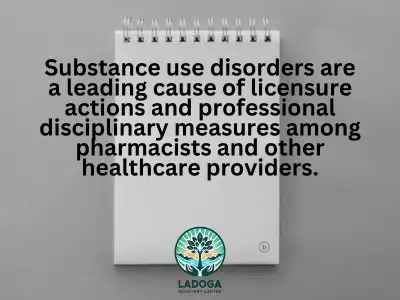Pharmacists play a critical role in healthcare, ensuring patients receive the medications they need safely and effectively. However, this profession is not without challenges. With direct access to prescription medications, high levels of stress, and demanding work environments, pharmacists are at an elevated risk for chemical dependency. Recognizing and mitigating these risks is essential for safeguarding their health, careers, and the communities they serve.
At Ladoga Recovery Center, we understand the unique pressures pharmacists face. Our evidence-based treatment programs, including Detox Treatment, Residential Treatment, Inpatient Treatment, and Prescription Drug Addiction Treatment, are designed to support professionals in overcoming addiction and reclaiming their lives. This article explores the challenges pharmacists encounter and offers five actionable suggestions to reduce the risk of chemical dependency.
Why Are Pharmacists at Risk for Chemical Dependency?
Pharmacists face unique circumstances that increase their vulnerability to substance use disorders. These include:
1. Access to Medications
Pharmacists handle controlled substances daily, often under minimal supervision. This constant access can create temptation, especially for those under stress or dealing with unresolved emotional issues.
2. Stressful Work Environments
Pharmacists work in high-pressure settings, juggling responsibilities such as filling prescriptions, counseling patients, and managing administrative duties. Long hours, heavy workloads, and the fear of making mistakes can lead to burnout and a reliance on substances to cope.
3. Normalized Substance Use
The medical community often normalizes the use of prescription drugs to manage pain, anxiety, or fatigue. Pharmacists may view controlled substances as a convenient solution to their challenges, downplaying the risks of dependency.
4. Fear of Stigma and Repercussions
Many pharmacists hesitate to seek help for substance use disorders due to concerns about judgment, professional reputation, or losing their license. This fear can delay intervention and exacerbate addiction.
Understanding these risk factors is the first step in creating effective prevention strategies.
1. Foster a Supportive Workplace Environment
A positive and supportive workplace culture can significantly reduce stress and the risk of chemical dependency among pharmacists. Employers play a critical role in creating an environment that prioritizes employee well-being.
Strategies for Employers:
- Promote Work-Life Balance:
Offer flexible scheduling, enforce reasonable work hours, and provide adequate staffing to reduce burnout. - Implement Wellness Programs:
Provide access to mental health resources, stress management workshops, and employee assistance programs (EAPs). - Encourage Open Communication:
Foster a culture where employees feel comfortable discussing challenges without fear of judgment or consequences. - Monitor Employee Well-Being:
Train supervisors to recognize signs of stress or burnout and intervene proactively.
Benefits:
Creating a supportive workplace helps pharmacists manage stress more effectively, reducing their reliance on substances to cope.
2. Establish Robust Monitoring and Accountability Systems
Given pharmacists’ access to controlled substances, implementing strict monitoring and accountability measures is essential. These systems help deter misuse and ensure the safe handling of medications.
Recommended Practices:
- Regular Inventory Audits:
Conduct routine audits of controlled substances to identify discrepancies and ensure compliance with regulations. - Controlled Substance Protocols:
Require dual verification for dispensing controlled substances and limit access to authorized personnel. - Random Drug Testing:
Introduce random testing to discourage misuse and identify issues early. - Automated Dispensing Systems:
Use technology to track medication handling and flag irregularities.
Benefits:
Accountability systems promote transparency, reduce opportunities for misuse, and create a safer work environment.
3. Provide Education and Training on Addiction Risks
Education is a powerful tool for prevention. Pharmacists should be equipped with knowledge about the risks of chemical dependency and how to protect themselves.
Key Topics to Cover:
- Understanding Addiction:
Teach pharmacists about the physiological and psychological aspects of addiction. - Recognizing Warning Signs:
Help pharmacists identify early signs of dependency in themselves or colleagues. - Stress Management Techniques:
Offer practical tools such as mindfulness, exercise, and time management strategies. - Encouraging Help-Seeking Behavior:
Emphasize that seeking treatment early is a proactive and responsible decision.
Benefits:
Educated pharmacists are better equipped to make informed choices, recognize potential issues, and seek help when needed.
4. Prioritize Self-Care and Stress Management
Pharmacists must prioritize their well-being to reduce the risk of burnout and dependency. Self-care is not a luxury—it’s a necessity for maintaining physical and emotional health.
Self-Care Practices for Pharmacists:
- Maintain a Healthy Lifestyle:
Regular exercise, a balanced diet, and adequate sleep are essential for overall well-being. - Practice Mindfulness:
Techniques such as meditation, yoga, or deep breathing can help reduce stress and improve focus. - Set Boundaries:
Learn to say no to excessive demands and create time for personal interests and relaxation. - Stay Connected:
Maintain strong relationships with friends, family, and support networks to counteract feelings of isolation.
Benefits:
By prioritizing self-care, pharmacists can build resilience, improve job satisfaction, and reduce their reliance on unhealthy coping mechanisms.
5. Seek Professional Help When Needed
Despite preventive measures, some pharmacists may still develop chemical dependency. Seeking professional treatment early is crucial for recovery and protecting their careers.
Treatment Options at Ladoga Recovery Center:
- Detox Treatment:
Safely manage withdrawal symptoms under medical supervision, ensuring a comfortable and secure detox process. - Residential Treatment:
Provide a structured environment for intensive therapy and skill-building, away from workplace stressors. - Inpatient Treatment:
Offer 24/7 care for severe addiction or co-occurring mental health conditions, such as anxiety or depression. - Prescription Drug Addiction Treatment:
Address the unique challenges of dependency on medications commonly handled by pharmacists. - Addiction Therapy:
Incorporate evidence-based therapies such as Cognitive Behavioral Therapy (CBT), trauma-informed care, and group counseling.
Benefits:
Professional treatment equips pharmacists with the tools to overcome addiction, rebuild their lives, and return to their careers with confidence.

Signs of Chemical Dependency in Pharmacists
Recognizing the signs of chemical dependency in pharmacists is essential for early intervention and effective treatment. Due to their unique access to prescription drugs and high-pressure work environments, pharmacists may be more adept at concealing their struggles. However, understanding the behavioral, physical, and professional indicators of dependency can help colleagues, supervisors, and loved ones identify when a pharmacist may need help.
1. Behavioral Signs
Chemical dependency often results in noticeable changes in behavior that deviate from a person’s usual demeanor or habits. Common behavioral indicators include:
- Secrecy and Isolation: Pharmacists may withdraw from colleagues or friends, becoming more secretive about their activities.
- Erratic Behavior: Sudden mood swings, irritability, or unexplained emotional outbursts may indicate underlying substance misuse.
- Frequent Excuses or Absences: Repeatedly leaving the workplace or avoiding certain tasks can signal an attempt to use or divert substances.
- Risky Decision-Making: Taking unnecessary risks, such as bending rules or improperly handling medications, may suggest impaired judgment.
2. Professional Performance Issues
Chemical dependency can have a significant impact on a pharmacist’s ability to perform their job effectively. Professional red flags include:
- Increased Errors: Making more dispensing or documentation mistakes than usual.
- Decline in Productivity: Struggling to keep up with workloads or missing deadlines.
- Disorganization: Losing track of inventory, failing to follow proper protocols, or mismanaging tasks.
- Frequent Complaints: Receiving patient or colleague complaints about attitude, focus, or reliability.
3. Physical Symptoms
Substance misuse often manifests in physical symptoms that may be difficult to hide. Key physical indicators include:
- Fatigue and Lethargy: Persistent tiredness or lack of energy, even after adequate rest.
- Physical Appearance Changes: Sudden weight loss, poor hygiene, or changes in overall appearance.
- Withdrawal Symptoms: Shaking hands, sweating, nausea, or other signs of withdrawal when substances are not available.
- Impaired Motor Skills: Difficulty with coordination, speech, or maintaining focus while performing tasks.
4. Emotional Distress
Pharmacists struggling with chemical dependency may experience heightened emotional turmoil, including:
- Increased Anxiety or Depression: Difficulty managing stress or an unusual sense of hopelessness.
- Irritability or Agitation: Becoming easily frustrated or upset without clear cause.
- Mood Instability: Frequent shifts between emotional highs and lows.
5. Inventory Irregularities
Access to controlled substances often leads to discrepancies in medication inventories. Warning signs include:
- Unexplained Shortages: Missing medications or discrepancies in inventory records.
- Altered Documentation: Falsified records or inconsistencies in tracking controlled substances.
- Frequent Handling of Specific Drugs: A pattern of involvement with certain high-risk medications.
Why Choose Ladoga Recovery Center?
At Ladoga Recovery Center, we specialize in treating healthcare professionals, including pharmacists, who are struggling with substance use disorders. Our comprehensive programs address the unique challenges faced by this population, offering personalized care and unwavering support.
Our Services Include:
- Detox Treatment:
Safe and medically supervised withdrawal management. - Residential Treatment:
A structured environment for intensive healing. - Inpatient Treatment:
Comprehensive care for severe addiction and co-occurring conditions. - Addiction Therapy:
Evidence-based approaches to address the root causes of addiction. - Aftercare Planning:
Ongoing support to maintain sobriety and prevent relapse.
Conclusion
Chemical dependency is a serious concern among pharmacists due to their high-stress work environments, direct access to prescription drugs, and the unique pressures of their profession. Recognizing the signs of dependency and taking action early can make a significant difference in preventing further harm and supporting recovery.
At Ladoga Recovery Center, we specialize in helping pharmacists and other healthcare professionals overcome addiction through personalized care and evidence-based treatment. From Detox Treatment to Residential Treatment and Addiction Therapy, our programs provide the tools needed to achieve lasting recovery while addressing the root causes of substance use disorders.
If you or someone you know is a pharmacist struggling with chemical dependency, seeking professional help is a courageous first step. Contact us today at (866) 609-8454 or visit our website to learn more about our comprehensive treatment options and how we can support your journey to a healthier, addiction-free future.
FAQ on Risk of Chemical Dependency in Pharmacists
Why are pharmacists at higher risk for chemical dependency?
Pharmacists have frequent access to controlled substances, work in high-stress environments, and face pressure to perform without mistakes, all of which can contribute to substance misuse.
What are the early signs of chemical dependency in pharmacists?
Common signs include increased secrecy, changes in behavior, declining work performance, frequent errors, and physical symptoms like fatigue or withdrawal signs.
How can workplaces help prevent chemical dependency in pharmacists?
Workplaces can promote a supportive environment by offering mental health resources, enforcing work-life balance, conducting regular inventory audits, and implementing monitoring systems for controlled substances.
What role does self-care play in preventing addiction?
Self-care practices like regular exercise, healthy eating, mindfulness, and maintaining a work-life balance can reduce stress and improve resilience, lowering the risk of dependency.
What professional treatment options are available for pharmacists struggling with addiction?
Programs like Detox Treatment, Residential Treatment, Inpatient Treatment, and Prescription Drug Addiction Treatment offer comprehensive care to help pharmacists recover and return to their careers.
Why should pharmacists seek professional help for addiction?
Professional treatment ensures safe detox, addresses the root causes of addiction, and provides tools for long-term recovery, helping pharmacists rebuild their lives and careers.

